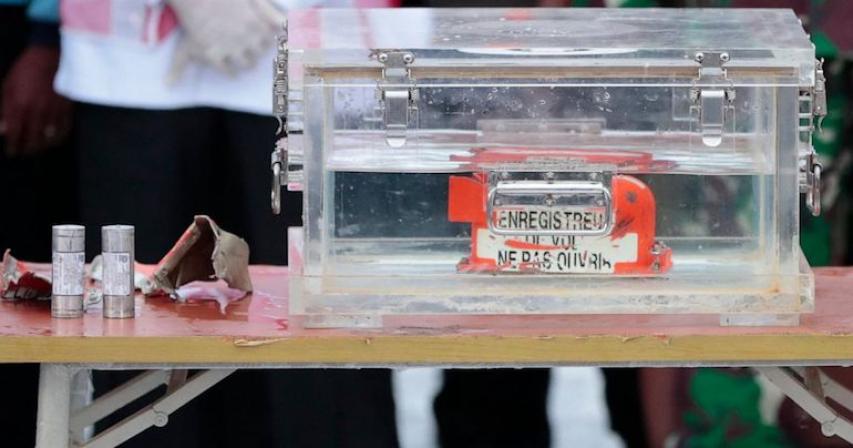Indonesian navy divers searching the ocean floor on Tuesday recovered the flight data recorder from a Sriwijaya Air jet that crashed into the Java Sea with 62 people on board.The device is expected to help investigators determine what caused the Boeing 737-500 to nosedive into the ocean in heavy rain shortly after taking off from Jakarta on Saturday.
The 26-year-old jet had been out of service for almost nine months because of flight cutbacks caused by the coronavirus pandemic, officials said. It resumed commercial flights last month.TV stations showed divers on an inflatable raft with a large white container containing the flight data recorder heading to a Jakarta port.
Military chief Air Chief Marshal Hadi Tjahjanto said the plane’s other “black box,” the cockpit voice recorder, was likely to be found soon because its beacon was being emitted in the same area.The devices were buried in seabed mud under tons of sharp objects in the plane's wreckage, navy Chief Adm. Yudo Margono said. He said at least 160 divers were deployed Tuesday in the search.
More than 3,600 rescue personnel, 13 helicopters, 54 large ships and 20 small boats are searching the area just north of Jakarta where Flight 182 crashed and have found parts of the plane and human remains in the water at a depth of 23 meters (75 feet).
So far, the searchers have sent 74 body bags containing human remains to police identification experts who on Monday said they had identified their first victim, 29-year-old flight attendant Okky Bisma.His wife, Aldha Refa, who is also a flight attendant for Sriwijaya Air, shared her grief in a series of posts on social media.
“My husband is a loving, devout and super kind man,” she wrote on Instagram. “Heaven is your place, dear ... be peaceful there.”
Anguished family members have been providing samples for DNA tests, and the National Police disaster victim identification unit said it has identified three more victims, including the co-pilot.
The chairman of Indonesia’s National Transportation Safety Committee, Soerjanto Tjahjono, ruled out a possible midair breakup after seeing the condition of the wreckage found by searchers. He said the jet was intact until it struck the water, concentrating the debris field, rather than spreading it out over a large area as would be seen with a midair event.
Tjahjono said the plane continued to send altitude data until it descended to 250 feet (75 meters) above the water’s surface.As in many countries, Indonesia's aviation industry has been badly hit by the pandemic, with travel restrictions and sharp declines in passengers. According to Transportation Ministry data, the jet didn’t fly from March 23 to Dec. 19.
The U.S. Federal Aviation Administration sent an airworthiness directive requiring operators of various Boeing 737 aircraft models, including the 737-500, to carry out engine checks before they can be flown again after being out of service. The order followed several reports of engines shutting down in mid-flight because of corrosion in a key valve.
Director General of Air Transportation Novie Riyanto said the plane was inspected on Dec. 2, including checks for engine corrosion, and was declared airworthy by the Transportation Ministry on Dec. 14.
The plane made an initial flight without passengers on Dec. 19 and resumed commercial flights on Dec. 22, according to ministry data. After returning to service, the plane made 132 flights, including the last one, according to information from aviation-data firm Flightradar24.Aviation experts said planes that are parked for long stretches can be returned to flight safely.
“It depends on how the airline maintains the aircraft while it is grounded,” said William Waldock, an aviation-safety expert at Embry-Riddle Aeronautical University in Prescott, Arizona. He said airlines should run engines periodically and perform other maintenance. “It tends to keep everything lubricated, and it reduces the likelihood of corrosion building up in places you don’t want it to be.”
John Goglia, a former member of the U.S. National Transportation Safety Board, said preparing a long-grounded jet can be an intensive and expensive chore, taking a team of mechanics up to two weeks to check engines and make sure that electronic, hydraulic and fuel systems are operating and free of contamination.
“My initial thought” on learning about the plane’s long grounding, “was if they did the proper due diligence,” Goglia said, “because sometimes that stuff doesn’t show up for a little while.”
The disaster has reignited concerns about safety in the aviation industry, which grew quickly after the economy was opened following the fall of dictator Suharto in the late 1990s. The United States banned Indonesian carriers from operating in the country in 2007, lifting the action in 2016, citing improvements in compliance with international aviation standards. The European Union lifted a similar ban in 2018.
Sriwijaya Air has had only minor safety incidents in the past, though a farmer was killed in 2008 when a plane went off the runway while landing due to a hydraulic issue.
In 2018, a Boeing 737 MAX 8 jet operated by Lion Air crashed, killing 189 people. An automated flight-control system played a role in that crash, but the Sriwijaya Air jet did not have that system on board.

Comments